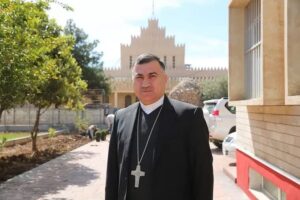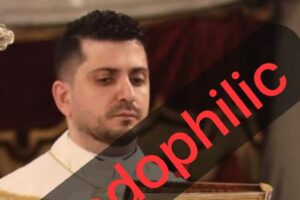One of the many problems with Latin liturgical reform over the last 40 years was being too heavily influenced by German and Swiss sources, and not enough by Byzantine ones.

The liturgical historian Fr. Robert Taft, S.J., is fond of saying that both the Latin and Byzantine liturgical traditions are “mongrels.” There is no such thing as a “pure” rite or liturgical tradition untouched by others.
Permit me, therefore, to attempt to shed some orientale lumen on important debates taking place here on CWR and elsewhere over the notion of “mutual enrichment” of the ordinary and extraordinary forms of Latin liturgy today. As a Byzantine Catholic, I might be expected to stay silently on the sidelines, not apparently having any direct stake. But one of the Western Church’s very own, the great English Dominican Aidan Nichols, in his valuable little book published by Ignatius Press twenty year ago now, Looking at the Liturgy, and even more in his unjustly neglected 1999 book Christendom Awake: On Reenergizing the Church in Culture, says that one of the many problems with Latin liturgical reform over the last 40 years was being too heavily influenced by German and Swiss sources, and not enough by Byzantine ones.
Precisely as a Byzantine Catholic in communion with my Latin brethren, I have watched with great anxiety the liturgical turmoil they have been enduring for more than forty years now and cannot stand idly by: when one part of the body suffers, we all suffer. Moreover, as a Catholic whose life’s work has been thus far devoted to rapprochement with Orthodoxy, I cannot stay silent when one of the concerns Orthodoxy has about communion with the pope of Rome is precisely his willingness to meddle, micromanage, and even destroy (or at least attempt to “abrogate”) something so venerable as the liturgy, the very source and summit of our life together.
If a Byzantine Catholic such as myself were foolish enough to attempt to offer some ideas to Latin discussions about liturgical enrichment and reform, what might those ideas consist of?
Perhaps, true to Eastern apophatic methods, it is easier to begin with a counsel of negation for the Western liturgist. First, stop sneering and sloganeering (“he’s not a liturgist!”) and pretending like you belong to some great guild of illuminati whose academic credentials qualify you and you alone to speak on these matters. Stop condescending to the people of God by claiming they cannot possibly understand what “consubstantial” or “oblation” mean. Have you tried to teach them? (After just two sessions last semester, the Roman Catholic students in my Trinity class were confidently and intelligently discussing Greek terms like ousia, perichoresis, and prosopon.)
Have you, moreover, ever seriously consulted the people of God about liturgical reform? Or was it imposed from the top down by a papal fiat beholden to a commission of ideologues? Leitourgia is indeed the “work of the people” or “public service.” Leitourgia is as much the “property” of (and as much performed by) the untutored, semi-literate baba—who kept the faith in the Soviet gulag, or under Islamic domination, and taught her children and grandchildren how to pray—as it is of anyone else, especially the so-called experts. She (“Mrs. Murphy” as the Latin liturgist Aidan Kavanaugh famously nick-named her) has as much right to contribute here as anyone swanning about with a graduate degree from the Anselmo.
Those experts made great hay claiming to find historical or Eastern antecedents for their reforms in the 1960s, as Taft showed in his important essay “Eastern Presuppositions and Western Liturgical Renewal”. Taft showed how often the Vatican II reformers invoked “the East” to justify what they had already decided to do. But in almost all these cases, the borrowed Eastern practice was then altered out of all recognition. The East has a circumnavigable altar? Sure. But the priest still stands in front of it, facing East, as do all the people. It is time, as I said last year on CWR, for the West to get over its orientophobia here.
The first kataphatic or positive way the East might enrich the West is by helping it answer anew the question: what is liturgy for? If a Western liturgist observes Eastern liturgy, he will not have to wait long for the answer: it is for the glorification of God in the most beautiful manner possible. In the East, the Divine Liturgy is called that for a reason: it is about worshipping God in the beauty of holiness.
To learn from the elaborate, complex beauty of Byzantine liturgy, you must first stop believing all the fantasies foisted on people in the 1960s, when it was put about that the liturgies of Christian antiquity were supposedly pristine examples of simplicity, accessibility, and transparency (a “community meal”) until they were cluttered up with “medieval accretions” that Vatican II had to remove. Read Catherine Pickstock’s magisterial reversal (in After Writing: On the Liturgical Consummation of Philosophy) of this romantic guff.
In this spirit, stop assuming that young people today want “simple” liturgy using “relevant” or “modern” music patterned on concerts or Protestant mega-churches. They don’t. For almost a decade now, I have been sending hundreds of students a year to Byzantine liturgy as part of a class assignment. Every single time they come back staggered by what they see. Time and time again they confess, almost in a stammer, “these people are serious about worshipping God!”
And it is worship they are seeing—not a Bible study or community rally or lecture imparting “information.” In this light, the West must stop assuming that liturgy is primarily pedagogical and that pedagogy involves propositional learning in discrete, non-repeated phases and phrases. Once more, pay careful heed to Pickstock’s unrivaled critique of the modern Mass’s problematic assumptions of linear time. The human mind does not work that way, nor especially the human heart.
All Eastern liturgical traditions understand this wisdom of loving repetition. We repeat because we love. Byzantine liturgy is replete with its repetitions, usually in groups of three, both because love demands repetition (the child flung into the air by Daddy screams what? “Do it again!”), and because threefold repetition is of course a mnemonic device bearing a Trinitarian imprint.
The West must therefore stop its psychologically destructive and perverse disdain for so-called useless repetitions. Repetition is the essence of liturgy and ritual. In this light, stop assuming a three-year lectionary is better than a one-year. It isn’t. One-year cycles mean more frequent repetition, which means a greater likelihood of people remembering the readings and calling them to mind later.
Hatred of repetition is invariably justified by self-congratulatory talk about “noble simplicity.” It is neither. “Noble simplicity” is just a sanctimonious display of bourgeois iconoclasm, with its fetishes for “cool, clean lines” and “decorative sparseness.”
Stop that iconoclasm. Reverse it, in fact. Fill your churches again with images and art. Use this as your rule of thumb: if you have any unclaimed bare space on any of your walls, hire an iconographer to fill it with images. The walls in the devil’s house are rightly cold and bare for he has no loved ones to call to mind: in God’s house, the walls are, or should be, absolutely full of the pictures of God’s friends, the saints and angels. God can never have too many friends, and his churches should not be afraid to have “too many” images.
In the East, images also help to screen off the altar with an iconostasis in front. Western churches have not developed such full icons screens, but they have had communion rails which should be restored—or, better yet, Western rood screens with images on them. These need not necessarily be Byzantine-style icons for there are plenty of beautiful Western liturgical artistic styles. But there is nothing preventing the West from fully adopting Byzantine imagery. (See the Church of Our Savior in New York for an example of a Latin parish that has done this.) For icons are for everyone—they are not some species of extraneous or exclusive “Eastern” exotica. (Find me the canon in the acta of Nicaea II that says the West can’t have icons in the same manner and style as the East.)
Nicaea II says images are “prototypes,” the veneration of which is passed over to the one represented. They are deeply to be reverenced, because in doing so we reverence Christ, who consecrated paint and wood and all of matter by assuming it in his flesh. But Christ is even more deeply to be reverenced in the Eucharist, his real flesh and blood.

There are many ways the East does this. First, it restricts distribution of communion, and the West should do likewise. Abandon the mania for fake jobs: stop the scandal of a dozen lay people traipsing up to the front to hand out the Eucharist to a few dozen parishioners like biscuits at a parish tea.
Second, demand more of people before the Eucharist by restoring the ancient requirement of fasting from midnight, as the East still does. In fact, restore more serious fasting throughout the year. Stop assuming people can’t fast today or don’t need to. Many of us spend too much of our time sitting in front of screens—not hauling coal out of the ground, or thousand-pound nets of fish out of the sea. A little fasting for us with our bloated existence is eminently suitable.
The other side of fasting, of course, is feasting. Stop treating feasts like playthings to be yanked around—Epiphany is January 6th. Not 5th or 9th or 3rd. January sixth. Ascension is forty (40) days after Pascha—not 43 or whatever Fr. Spadaro’s new math would have us believe.
Stop short-changing feasts by racing back to something bearing the hideous name of “ordinary time.” (Count them, as we do, “Sundays after Theophany” or “Sundays after Pentecost.”) Feasting should continue on beyond what the world considers seemly or “enough.” Therefore restore the octaves: Pentecost, Assumption, and Epiphany for a start.
To further deepen reverence for the Eucharist, stop treating liturgy like a talk show. Stop talking entirely and instead start singing the liturgy. All of it. Every time.
“But it will take too long!” many pampered pew-sitters protest. Nonsense. I regularly serve a fully sung Byzantine liturgy of St. John Chrysostom done exactly as the liturgical books prescribe for Sundays, and this can be done beautifully and without rushing in 75 minutes. I have also regularly attended a missa cantata in the extraordinary form on Sundays, also done in about 75 minutes. In no way is this some great hardship for people who spend four hours watching football Sunday afternoon or two hours every night playing Minecraft.
But, while important and to be treated with reverence, liturgy is not some dour gathering of only the pious. It is, rather, a playground, but with rules, costumes, and roles to be played with a kind of exacting informality. There is a liturgical dynamic in the East that is perhaps hard to replicate, but attempts should be made. Liturgy is both serious and informal, solemn and joyful. Perhaps the best word for it is playful. As it happens, the person who has most eloquently and yet succinctly captured this dynamic is a Latin: see Romano Guardini’s book The Spirit of the Liturgy, especially chapters five (“The Playfulness of the Liturgy”) and six (“The Seriousness of the Liturgy”) for a masterful juxtaposition.
Such playfulness must not be misunderstood: Sunday liturgy is not an opéra bouffe. But like good opera or music or theatre, liturgy should allow us to forget about ourselves, to be transported beyond the mundane. Such playfulness must ultimately allow everyone—as Pope John Paul II put it in describing Eastern liturgy in Orientale Lumen—room for “total involvement of the person in…‘ecstasy’ and in immanence.”
Ecstasy. Some Latin liturgists would tell you this is another tricky bit of diction people are too dim to grasp. Be not afraid: we can master it! It comes from the Greek ek-stasis, for “standing outside oneself.” Liturgy should allow us to stand outside of ourselves in order to stand more fully in God. As the cherubic hymn of the Byzantine tradition, usually repeated several times during the major introit or great entrance, puts it
Let us who mystically represent the Cherubim,
and who sing the thrice-holy hymn to the Life-Giving Trinity,
now lay aside all earthly cares
that we may receive the King of all,
escorted invisibly by the angelic hosts.
Alleluia!
If we are to stand outside of ourselves and worship God with the whole heavenly host, then surely love demands that we spare no effort and no expense to make things as beautiful as possible, including not just buildings, but all the liturgical accoutrements needed. This will cost money. Ask people to sacrifice, and tell them while doing so that the money taken to build beautiful churches will not snatch food away from starving babies. This is a slander advanced by bores. Pay them no mind.
Your mind, indeed your whole self, should be taken outside of itself so that, after every liturgy, you can, as with the emissaries of Grand Prince Vladimir to the Great Church of Hagia Sophia in Constantinople, exclaim in : “I knew not whether I was in heaven or on earth. But I cannot forget that beauty. Only this I know: that here God dwells with us!” Let that be the standard and the goal for all liturgy, Eastern and Western, ordinary and extraordinary. God deserves no less—and so do His people.
















